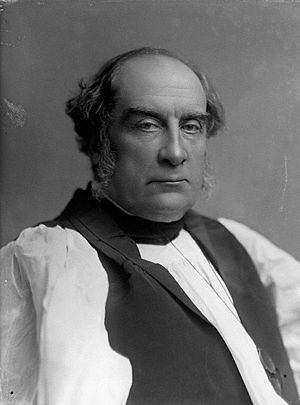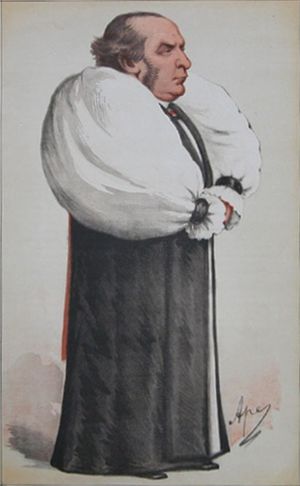William Thomson (bishop) facts for kids
Quick facts for kids The Most Reverend and Right Honourable William Thomson FRS FRGS |
|
|---|---|
| Archbishop of York | |
 |
|
| Church | Church of England |
| Province | Province of York |
| Diocese | Diocese of York |
| Elected | 1862 |
| Reign ended | 1890 (death) |
| Predecessor | Charles Longley |
| Successor | William Connor Magee |
| Other posts | Bishop of Gloucester and Bristol |
| Personal details | |
| Born | 11 February 1819 Whitehaven, Cumberland |
| Died | 25 December 1890 (aged 71) |
| Buried | Bishopthorpe |
| Denomination | Anglican |
| Spouse | Zoë Skene |
| Education | Shrewsbury School |
| Alma mater | The Queen's College, Oxford |

William Thomson (born 11 February 1819, died 25 December 1890) was an important English church leader. He served as the Archbishop of York from 1862 until his death. This was a very high position in the Church of England. He was also a member of the Royal Society and the Royal Geographical Society.
His Early Life and Education
William Thomson was born in Whitehaven, a town in Cumberland. He was the oldest son of John Thompson. William went to Shrewsbury School for his early education.
After school, he studied at The Queen's College, Oxford. He was a very good student and became a scholar there. In 1840, he earned his first degree. Soon after, he became a fellow of his college, which is like being a senior member or teacher.
In 1842, William became a priest. He worked as a curate, helping the main priest in a church in Cuddesdon. By 1847, he was a tutor at his college in Oxford. In 1853, he gave a series of important talks called the Bampton lectures. These talks were about "The Atoning Work of Christ." These lectures helped him become well-known.
His Career and Achievements
William Thomson was interested in more than just theology (the study of religion). He was made a fellow of the Royal Society, which is a famous group for science. He also became a fellow of the Royal Geographical Society, which focuses on geography.
He wrote a popular book called Outline of the Laws of Thought in 1842. This book was about how we think. At Oxford, he supported changes to the university. In 1855, he became the provost of his college. This means he was the head of the college.
In 1858, he became a preacher at Lincoln's Inn, a famous place for lawyers. He published some of his sermons (church talks) in 1861. In the same year, he helped edit a book called Aids to Faith. This book was written to support traditional church ideas against some new, more modern views.
In December 1861, William Thomson became the Bishop of Gloucester and Bristol. A bishop is a senior leader in the church. Just one year later, he was chosen to be the Archbishop of York. This is one of the two most important roles in the Church of England.
As Archbishop, he was known for his sensible and clear thinking. He worked with Archbishop Archibald Campbell Tait to support a law called the Public Worship Regulation Act. This law aimed to make church services more orderly. He was also the president of the northern convocation, a church meeting group. He sometimes disagreed with others in this group.
Even though some church members didn't always agree with him, many ordinary people admired him. They liked his strong sense, clear arguments, and wide knowledge. He remained a very influential person in the north of England. Later in his life, he gave more talks and wrote articles. He also helped start the Speaker's Commentary, a large set of books explaining the Bible. For this, he wrote the introduction to the Synoptic Gospels.
His Family Life
William Thomson's parents were John and Isabella Thompson. On 24 July 1855, he married Zoë Skene in Oxford. Zoë was the daughter of James Henry Skene, who was a British Consul.
William and Zoë had several children together. One of their children was Ethel Zoë Thomson. She later helped edit a book about her father's life and letters. Another notable child was Sir Basil Home Thomson. He became a famous British intelligence officer and writer.


